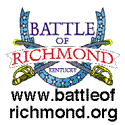|
American Civil War special for Germans
as historical event ‘worth remembering’
Germany is one of those European countries that traditionally observes the American Civil War. The question is, WHY?
A primary reason is that some 200,000 who had German roots fought in the War Between the States. And, unlike its World Wars, that’s a history Germans feel is worth remembering.
Because many Germans feel the Civil War is important to their history, participating in re-enactments makes them feel “closer to that history.” And, to become closer to that heritage, re-enactments featuring women in hoop skirts and men in handmade Union and Confederate uniforms are staged in events across the country.
Some say the re-enactments are appealing because the U.S. Civil War took place in another country and in another time. The events are safe fantasies, one German recently commented, noting that “life needs fantasies.” And, because Germans “like to do things 110 percent,” they want to do things the way they were then.
The Civil War is rich with German culture. Immigrants from Germany itself, as well as Austria and the Netherlands, came to the United States in the decades before the war. Between 1850 and 1860 alone, the number of immigrants from what was then known as the German Empire more than doubled, from a little more than a half million to more than one million just before the war began.
Hardworking and organized, the Germans settled, as did most newcomers to America, in places that reminded them of home. Places such as the Appalachians and the Blue Ridge were not as dramatic as the Alps, but they were mountains, and they had as near neighbors the rolling hills and meadows of the Piedmont and the coastal regions.
Concentrated around Pennsylvania, Delaware, parts of Maryland and Virginia, and on up into New York, the Germans and their Dutch cousins settled and left their mark upon those regions, and came forth to serve their adopted land when hostilities erupted between the North and South in 1861.
German-Americans were the largest ethnic contingent to fight for the Union.
Approximately 516,000 - or about 23 percent of all Union soldiers - were German Americans with about 216,000 of these born in Germany. New York supplied the largest number of native-born Germans with 36,000. Behind the Empire State came Missouri with 30,000 and Ohio with 20,000.
In 1860, more than four out of five Germans in the United States were living in the Free States, and two out of three were concentrated in just five states – New York, Pennsylvania, Ohio, Illinois and Wisconsin. The border states, consisting of Delaware, Maryland, Kentucky and Missouri, contained about 15 percent of the country’s Germans, and the Slave States in the South contained a little more than five percent.
Germans overwhelmingly chose to live in the Free States because they did not have to compete with slave labor and the Free States were more industrialized, offering better economic opportunities. Germans also disliked the institution of slavery because it was akin to the serf system they detested in their homelands.
Kentucky, being a Slave State, attracted fewer Germans than if it had been a Free State, and its German-born population numbered approximately 27,000 persons in 1860. One of the main reasons for German settlement in Kentucky was the development of manufacturing interests along its Ohio River border, principally in Louisville, Covington and Newport, and to certain settlements of agriculturalist Germans in counties along the northern border of the state.
The relatively small number of slaves in counties along Kentucky’s northern border was another reason Germans moved into this part of the Commonwealth. While slaves accounted for about 20 percent of Kentucky’s total population of 1,150,000 in 1860, they aggregated less than eight percent of Louisville’s population and less than two percent of that of Covington and Newport. It’s noteworthy that approximately 50 percent of Kentucky’s native-Germans lived in Louisville, and the cities of Covington and Newport (combined) contained almost 20 percent of the state’s German population.
Kentucky’s German-Americans served almost totally in the Western Theater of the war. The 6th Kentucky Infantry, which had four German companies, fought principally in Kentucky, Tennessee and Georgia as part of the Army of the Ohio and its successor Army of the Cumberland. And, it was among the best fighting units provided to the Union army by its respective states.
The 4th Kentucky Cavalry, with its three German companies, campaigned in Kentucky, Tennessee, Alabama, Georgia, and even reached Tallahassee, Fla., late in the war. It engaged in scouting duties and raids, and fought Confederate cavalry on many occasions.
The 22nd Kentucky Infantry, whose Company K was composed of Germans from Louisville, began its service in Eastern Kentucky and later moved west and fought at Chickasaw Bayou and Chickasaw Bluffs in Mississippi in December 1862 and was at Arkansas Post, Ark. The 22nd Kentucky also campaigned in Louisiana.
Commonly referred to as "Dutchmen" by other Union soldiers, and "lop-eared Dutch" by Confederates, German-American units in general earned a reputation for discipline and ruthlessness.
Despite their Union connections, some Germans, however, found their sympathies to be with the Southern cause. One of the most interesting German figures was Gen. JEB Stuart's aide, Major Johann August Heinrich Heros Von Borcke. Tall, handsome and blond, Von Borcke came from an old Prussian military family of titled nobility. Serving in the Second Brandenburg Regiment of Dragoons when the Civil War began, young Heros landed in Charleston in May 1862. Introduced to Stuart by Confederate Secretary of War George Randolph, Von Borcke quickly became a dear friend of the equally young Confederate commander and, from then on, the Prussian rarely was far from Stuart's side.
|











